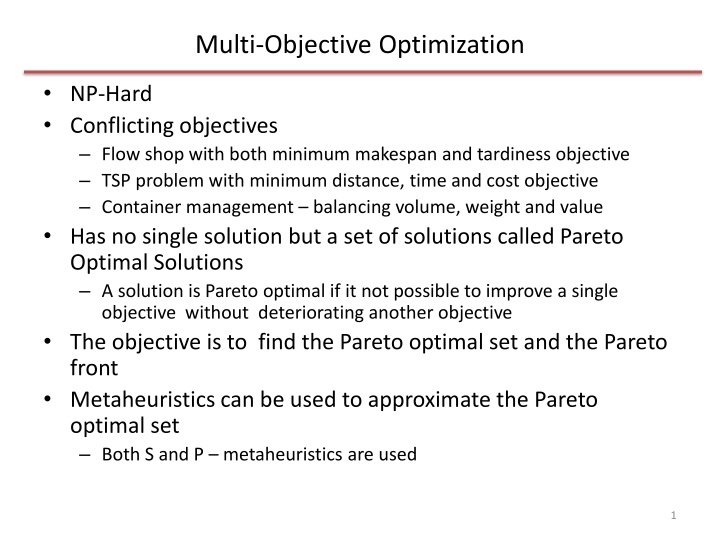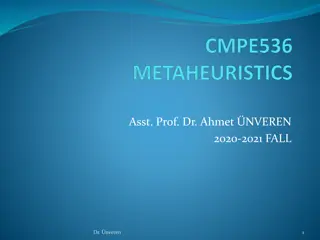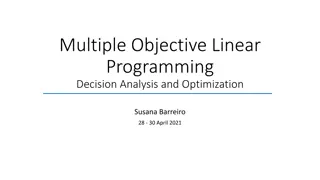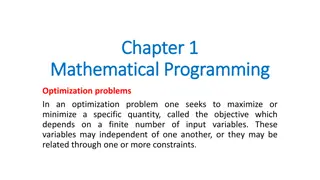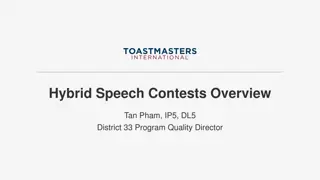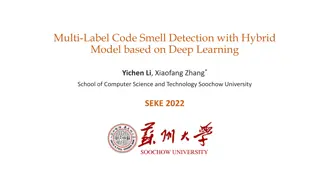Metaheuristics and Hybrid Approaches in Multi-Objective Optimization
Multi-objective optimization involves solving complex problems with conflicting objectives, such as minimizing makespan and tardiness in flow shop scheduling. Pareto Optimal Solutions are sought, where improving one objective cannot be done without worsening another. Metaheuristics like S and P methods are used to approximate the Pareto optimal set. Hybrid approaches combine various metaheuristics and AI techniques to tackle NP-hard problems efficiently. Parallel metaheuristics speed up the search process by utilizing multiple computing resources.
Download Presentation

Please find below an Image/Link to download the presentation.
The content on the website is provided AS IS for your information and personal use only. It may not be sold, licensed, or shared on other websites without obtaining consent from the author.If you encounter any issues during the download, it is possible that the publisher has removed the file from their server.
You are allowed to download the files provided on this website for personal or commercial use, subject to the condition that they are used lawfully. All files are the property of their respective owners.
The content on the website is provided AS IS for your information and personal use only. It may not be sold, licensed, or shared on other websites without obtaining consent from the author.
E N D
Presentation Transcript
Multi-Objective Optimization NP-Hard Conflicting objectives Flow shop with both minimum makespan and tardiness objective TSP problem with minimum distance, time and cost objective Container management balancing volume, weight and value Has no single solution but a set of solutions called Pareto Optimal Solutions A solution is Pareto optimal if it not possible to improve a single objective without deteriorating another objective The objective is to find the Pareto optimal set and the Pareto front Metaheuristics can be used to approximate the Pareto optimal set Both S and P metaheuristics are used 1
Metaheuristics for Multiobjective Optimization Fitness assignment assign a scalar value to the quality of the solution Diversity preserving generate a diverse set of solutions Elitism Select the best set of solutions at every step General strategies Aggregation use an aggregation method to covert the problem into mono-objective Weighted Metric preselect a reference value of the objective function and measure the distance of the other solutions from this reference and minimize this distance Parallel approach- treat each objective individually. Then crossover and mutate the solutions from each objective to find a compromise Sequential approach- search in a preference order of objectives Dominance based- search using a dominant criteria set by the final user 2
Hybrid Metaheuristics Combining S and P or a S and S metaheuristics Combining with other math programming methods Metaheuristics and AI Main classification Relay - sequential Teamwork cooperative search Example. Embedding metaheuristics search within other optimization solution methods Branch and bound the upper bound of a node can be obtained using metaheuristic which also yields a partial solution upto the given node Dynamic programming- if the state-action space is large, metaheuristics can reduce the action space by performing a local search among a set of all possible actions for a state 3
Parallel Metaheuristics Speed up search Improve quality Solve large NP hard problems Parallel designs Algorithmic level Independent or cooperative self-contained metaheuristics approaches are used in parallel Iterative level At an iteration, search is done in several neighborhoods by different computers to speed up search, reconcile the solutions periodically Solution level- the generation of the objective function value and the check for any constraint violations is done in parallel for a set of solutions generated by one search 4
Elements of the Heuristic Approach Representation of the solution space Vector of Binary values 0/1 Knapsack, 0/1 IP problems Vector of discrete values- Location , and assignment problems Vector of continuous values on a real line continuous, parameter optimization Permutation sequencing, scheduling, TSP Defining the neighborhood and the neighbors Flip operator binary or over a range of numbers (+1 or -1 as in knapsack) Permutation operator pair-wise exchange operator Insertion operator 12345 14235 Exchange operator 12345 14325 Inversion operator 123456 154326 5
Implementation - Chapter 14 -15 Summary 6
Elements of the Heuristic Approach Defining the initial solution Random or greedy Choosing the method (algorithm for iterative search) Off-the shelf or tailor made heuristic Single-start or multistart (still single but several independent singles) or population (solutions interact with one another) Strategies for escaping local optima Balance diversification and intensification of search Objective function evaluation Full or partial evaluation At every iteration or after a set of iterations Stopping criteria Number of iterations Time Counting the number of non-improving solutions in consecutive iterations. Remember: there is a lot of flexibility in setting up the above. Optimality cannot be proved. All you are looking for is a good solution given the resource (time, money and computing power) constraints 7
Single-Metaheuristics Accept nonimproving neighbors Tabu search and simulated annealing Iterating with different initial solutions Multistart local search, greedy randomized adaptive search procedure (GRASP), iterative local search Changing the neighborhood Variable neighborhood search Changing the objective function or the input to the problem in a effort to solve the original problem more effectively. Guided local search 8
Population-based metaheuristics Nature-inspired Initialize a population A new population of solutions is generated Integrate the new population into the current one using one these methods by replacement which is a selection process from the new and current solutions Evolutionary Algorithms genetic algorithm Estimation of distribution algorithm (EDA) Scatter search Evolutionary programming- genetic programming Swarm Intelligence Ant colony Particle swarm optimization (PSO) Bee colony Artificial Immune system AIS Continue until a stopping criteria is reached The generation and replacement process could be memoryless or some search memory is used 9
Summary of Other Heuristics From Text See webpage and Text 10
Next Sem Dynamic Programming Next Fall Approximate DP Thank YOU! 11
